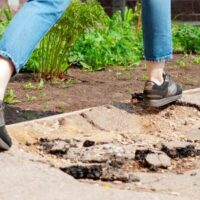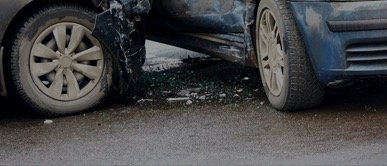Falling Into Holes: Funny In Cartoons, Dangerous In Real Life

In the movies or in cartoons, when a character falls into a giant hole, it’s usually pretty comical. But in real life, holes can be very dangerous, and crippling. Holes in real life normally aren’t the type of holes that are large enough for our entire body to fall into—helpfully those are few and far between, and observable. Rather, it’s the holes that are small enough for your foot to go into, that can cause catastrophic damages.
How Do Holes Open Up?
Holes can happen for a number of reasons. Often, landscapers will dig, and leave holes in the ground. Plants, small trees or foliage may be removed, but the holes left by their removal may not be filled in. Even hard surfaces can create holes. Potholes in asphalt are very common.
Why the Danger?
Holes in the ground are particularly dangerous, because when we step, the musculature in our body and leg prepare for impact with the ground. When the ground isn’t where we expect it to be because of a hole, our foot, angle, knee, and entire lower extremities, aren’t ready for the impact.
The result can be crushing and devastating injuries to any part of our legs and feet.
Laws Regulating Open Holes
Holes are so dangerous, Florida has enacted laws that specifically deal with them. The law forbids leaving holes in the ground that are wider or deeper than 2 feet. If the hole exists, it must by law have a fence or other barrier sufficient to avoid people or animals from stepping into it.
The danger of open holes is so dangerous, the law even allows victims to recover two times their damages, if they are injured by an open hole in the ground.
Premises Liability
Holes are treated much the same way as any danger on landowners property. Just as a landowner would have to clean a spill, or take away a piece of debris that may be where people walk, so too does a landowner have to fill or at least mark off a hole in the ground.
In many cases, the landowner will try to defend a case by saying that a hole is open and obvious. But in reality, many holes are not obvious. They are often covered by shrubbery, bushes, or simply overgrown surrounding grass or foliage.
Who is Liable?
Although it may seem like holding a party liable for a hole in the ground is an easy, straightforward case, it often is not. That’s because often, multiple parties may be responsible for digging, leaving open, or failing to barricade the hole.
Businesses may contract with third party landscapers, maintenance companies, or other contractors that leave holes open. The city may leave a hole open on a private business’ property. Finding out who actually dug and worked on the hole can be a difficult part of any injury case involving injury by stepping into a hole in the ground.
Were you injured on someone else’s property? Schedule a consultation today with the Tampa personal injury lawyers at Barbas, Nunez, Sanders, Butler & Hovsepian if you sustain any kind of injury in an accident.
Resource:
flsenate.gov/Laws/Statutes/2011/768.11




